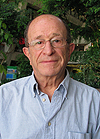Carlos Hojvat retires after 35 years

Carlos Hojvat
Carlos Hojvat first worked at Fermilab as a Research Associate at McGill University in Montreal, Canada, working on a large-momentum-transfer proton-proton scattering experiment in the Proton Area at a time when rubber boots were mandatory. He joined Fermilab on January 1, 1977, as a full-time employee and a member of the Accelerator Division. He also held positions in the Research Division, the Director’s Office and more recently in the Experimental Physics Projects group of the Particle Physics Division. He retires today.
Hojvat’s first project was the negative hydrogen multi-turn injection for the Booster accelerator, which allowed record beam intensities and the development of the very thin stripping foils. Reporting to then-Director Leon Lederman, he worked on understanding the relationship between the superconducting Tevatron magnets’ thermal cycles and the instability of the magnetic field direction. This opened the way to the invention of the famous “smart bolts.” He headed the group that designed and built the antiproton target station and its large-current lithium collecting lens as part of the Tevatron I Project. At the Tevatron, Hojvat collaborated on a search for quark-gluon plasma at the C0 intersection region.
In late 1992, Director John Peoples appointed Hojvat to assist with budget planning and negotiating memoranda of understanding with experimental groups. He was also responsible for test beam facilities for experiments at the eventually canceled Superconducting Super Collider.
In 1996, Hojvat became deputy project manager of the Pierre Auger Observatory, a project established to search for the origin of the highest-energy cosmic rays. He set up the administrative infrastructure for the observatory and hired personnel at the site in Mendoza, Argentina. He also formed the Fundación Observatorio Pierre Auger Argentina as the local legal entity to manage the financial and administrative details for operating the observatory. He also collaborated with the local municipality to establish the first digital planetarium in Argentina. Now fully operational and host to several educational programs, it has a full schedule of visits by schools from as far away as Buenos Aires and Chile. In addition, Hojvat helped produce educational videos related to the goals of the observatory.
After retirement, he will continue his responsibilities as president of the foundation, spend time with and enjoy his grandchildren and do a little fly fishing.


